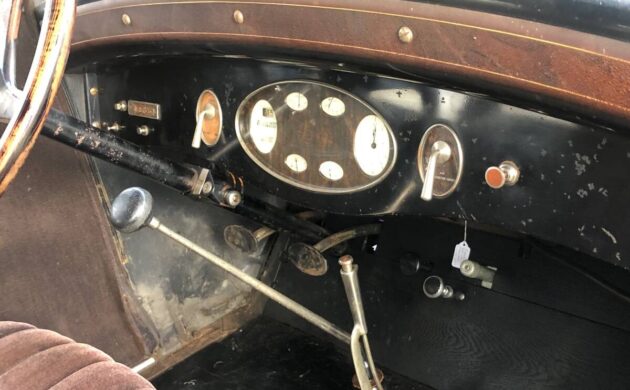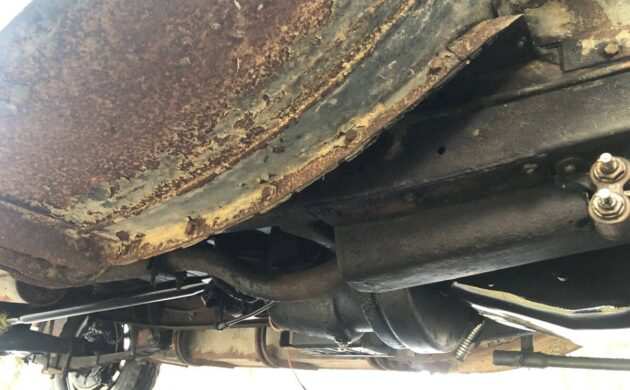Here on craigslist, we have a 1927 Chrysler Model 70 Finer Landau Brougham for sale at $8,500. This car is just a few years removed from the very first car made under the Chrysler name, the Model B 70, so we are looking at one of the earliest Chryslers in existence. Nomenclature in the early years of Chrysler was confusing, but generally, the Series 60 and 70 arrived on the heels of similarly-named cars, but now with six-cylinder motors. The numbers (60, 70) referred to attainable top speed. Hydraulic brakes were offered at this price point – unheard of in the market as yet – and the ride also benefited from rubber engine mounts, helping to dampen vibrations. Bodies were by Fisher and customers could choose among several configurations, or even specify custom options. This four-door sported suicide doors. In keeping with the slightly hokey marketing tactics of the day, the Model 70 was divided into two series, with the earlier series being “normal” and the later series, with one less wheel lug and different tires as well as subtle upgrades being the “finer” series. This car is located in Lagrangeville, New York. Thanks to Rocco B. for this heirloom tip!
Someone has tended to at least a few of this car’s needs already. The six-cylinder has “been gone through” and received a new timing chain and fresh fluids. The fuel lines are new, the gas tank is restored, and the vacuum tank was rebuilt. Its artillery wheels have been refinished, and it has new tires. The battery is new and the car runs and drives. It stops, too, as the brakes have been rebuilt. The seller indicates that a few of the harness wires still need to be connected, but at least they are tagged.
The interior is slightly worse for wear; the fabric on the seats was a high-quality mohair, which ought to be available today. The dash design changed from the early to late Model 70; this and other differences in parts make it critical to know whether you have a “finer” or an earlier Model 70. This car has an interior rear heater – rare for the day. One rear door glass is compromised and the window cranks have gone missing.
The underside reveals at least some of the work performed. The exhaust is said to be sound, and the seller says there’s no filler or rust in the body. While I think the roadsters are more attractive, this car offers a lot for the price as long as a buyer can be happy with most of the cosmetics. What do you think of the asking price here?




I wish I were a younger man and had the time to restore this myself. These prewar cars were still seen in the English countryside when I was a lad. Cars were expensive so people cared for them decade upon decade and the result was a supply of interesting rides from multiple generations. What I would give to be able to drive something like this on a nice fall afternoon. Alas, the sums in our bank account are destined to do more noble things, like help pay for grandkids college funds. I may miss out on a few rides, but I can go to my grave knowing that our family will continue to prosper.
For a car approaching the century mark, the overall condition of this classic Chrysler looks pretty good. It doesn’t look like the new owner will have to tackle any mechanical work, just the cosmetics. The interior needs some work but seems complete. A fresh coat of paint in its original colors and you’ll end up with a very nice classic. There’s not a lot of chrome present on this car so hopefully any that’s there can be cleaned up but if re-chroming is needed, there’s not a lot to have done. I like this car; it’s looks like a fun car to work on and enjoy. The wood artillery wheels are particularly attractive. The price seems very fair for what you’d be getting, too.
The authors here are as unique as the cars they feature. We’re starting to see what makes them tick, merely by the vehicles they write up. Scotty needs no introduction, but Michelles interests are, well, interesting,,,for a girl, KIDDING! just threw that John Candy “Spaceballs ” line in there. If something like this is posted, almost guaranteed its from her. I don’t know her age, but clearly born too late. Quick correction, by 1927, most of the cars EXCEPT Ford, had juice brakes. Fact is, Chrysler was one of the pioneers offering them in 1924. The seller is clearly going on the “this is what an old car looked like” theme, and looks awful. This person should have maybe put more into the appearance. Nobody is going to see a shiny motor, but the outside is the 1st thing they will see, and will be immediately turned off. I know I am. Give this old gal some dignity for heavens sake.
Hi Howard, since I often get the brakes thing wrong I checked this twice. What I learned was that for this price point, hydraulics were not offered. Chrysler offered them standard at the lowest price point on the market at the time. Much was made of this in every source I read so I threw it in the article.
I am 63 and have been collecting cars since I was 25. We have four prewar cars. My Christmas present this year was a 1931 Model A. It is SO cool! But I can find a reason to love almost every old car I see. I would be thrilled to have this old gal in my barn!
I agree Michelle…. these cars have a character that the new cars can’t touch. I would spend a little time getting the outside a bit nicer with some spit and polish. I would make sure the engine is in good shape, and then the interior… it doesn’t have to be perfect… but then, what is ever perfect??
I like it, Howard may not… that’s why we have horse races, isn’t it? It’s a good thing to have a difference in taste.
My friend has a 26 model it has a replacement motor in it don’t think I can send pictures it looks nice
Both Ford Motor Company (Ford and Lincoln) and General Motors (Chevrolet, Oakland/Pontiac, Oldsmobile, Buick, LaSalle and Cadillac) continued with mechanical brakes until the mid-’30s. In 1924, Chrysler inherited Maxwell’s Lockheed hydraulic brake system and adopted it on their other brands (Dodge, DeSoto and Plymouth).
So, of the “Big Three” (Ford Motor Company, General Motors and Chrysler Corporation), only Chrysler Corporation vehicles had hydraulic brakes in the 1920s and early ’30s.
Most GM cars still had mechanical brakes until the mid 30’s
Those bumpers are not only ugly but wrong for the car and would be the first to go.
For many cars in the 20’s, bumpers were optional equipment, not standard. Many owners just purchased after market bumpers, which is possibly how this car is equipped. In AACA judging as long as these bumpers are from the 1927 era, they are correct. .
These cars helped Chrysler to develop a reputation for advanced engineering. In fact, in the late 1920s, Model 70 Roadsters raced at Le Mans. Were this a Roadster, it would be priced much higher and still snapped up.
IMO this is a screaming deal. Were I just a bit younger and had shop space to store it, I would love to have this to tinker with. I would try to source more attractive bumpers, and reupholster it as finances allowed but otherwise, I love everything about it.
An interesting, if perhaps lost, bit of history is that, starting in 1925, Chrysler ran at LeMans, finishing 7th in 1925, 3rd and 4th in 1928 (behind the winning Bentley and second-place Stutz, 6th and 7th in 1929. They were also competitors at Spa during those years. (source: “Chrysler in Competition” by Jones & Swig)
(1) You asked about price. It is a bargain!
(2) You said it is fitted with rubber engine mounts to improve ride. Rubber engine mounts (motor mounts in US jargon) were not fitted to Chrysler products until 1931 or 32 but I think 32 is correct depending on how the year model was determined.
(3) What could have been fitted (but 1927 appears a bit early) were rubber bushes in one end of the suspension leaf spring. Certainly they had this in 32 and I think this is what you meant about improving ride.
These do have Chrysler’s patented “Floating Power” engine mounting system, where the engine rests on a single central front engine mount, a single central rear engine mount, and a rubber-mounted transverse spring, to isolate the body and frame from torsional vibrations. The feature was added to Dodge and Plymouth in the ’30s
Dear GitterDunn. I have just made a quick search of Chrysler engine mounts. From what I have read I am correct about Floating Power. However, I found that Chrysler developed a rubber engine mount in 1925 but it was not Floating Power which was new for 1932.
Your description of Floating Power is correct as it used two engine mounts only and a small leaf spring attached to the chassis to counteract the engine torque. One mount was high up under the water pump and the other low down around the gearbox. Their position was such that if you draw a line from the front to rear mount it was the line of the centre of mass of the engine and gearbox combined. It could freely spin around that line and stop in any position if the rubber was replaced by a bearing. The leaf spring reacts to the engine engine torque. My 32 DM Dodge 4-cylinder has Floating Power and the engine rocks a great deal at idle and anyone who doesn’t know this system thinks the mounts are broken but they are not.